| Columns Retired Columns & Blogs |
and it costs 3K USD
I measured the Devialet Expert 140 Pro using my Audio Precision SYS2722 system (see the January 2008 "As We See It"). The amplifier as received was set to "High Pass 10Hz, Max. Level 2.0V." I usually precondition amplifiers by running them at one-third power into 8 ohms for an hour, which is thermally the worst case for a class-AB output stage. As the Devialet has a (partly) digital output stage, the preconditioning wasn't necessary. Nevertheless, the amplifier ran warm, with the top panel measuring 119.9°F (48.9°C) an hour or so into the testing. The menu's internal temperature function indicated the message "Temp. A Amp 61°C; Temp. D Amp 57°C; Temp. Supply 65°C." The Expert 140 Pro should be positioned where it is well-ventilated.
As I always do with class-D amplifiers, I inserted an Audio Precision auxiliary AUX-0025 passive low-pass filter, which eliminates noise above 200kHz, between the test load. This eliminates the risk of driving the analyzer's input stage into slew-rate limiting, which would interfere with the distortion measurements. Without the Audio Precision filter, there was 120mV of ultrasonic noise present at the amplifier's outputs.
Looking first at the unbalanced line-level analog inputs, the Devialet's voltage gain into 8 ohms with the volume control set to its maximum of "30" was 48.5dB, which is a little higher than is usual for an integrated amplifier. The gain with the control set to "0.0" was exactly 30dB lower. The amplifier preserved absolute polarity (ie, was noninverting) with Phase set to "+." My measurements indicated an input impedance of a suitably high 16.5k ohms at 20Hz and 1kHz, this dropping inconsequentially to 15.7k ohms at 20kHz.
The output impedance is specified as an extraordinarily low 0.001 ohms. I measured a still-low 0.05 ohms from 20Hz to 20kHz, this figure including the series impedance of 6' of loudspeaker cable. As a result, the response with our standard simulated loudspeaker varied by less than ±0.05dB (fig.1, gray trace) and the response into 2 ohms (fig.1 green trace) was almost identical to that into 8 and 4 ohms (fig.1, blue, red, cyan, and magenta traces). As expected from the settings, the low-frequency response was –3dB at 10Hz. The output into 2 ohms (gray trace) was down by just 0.125dB at 20kHz.
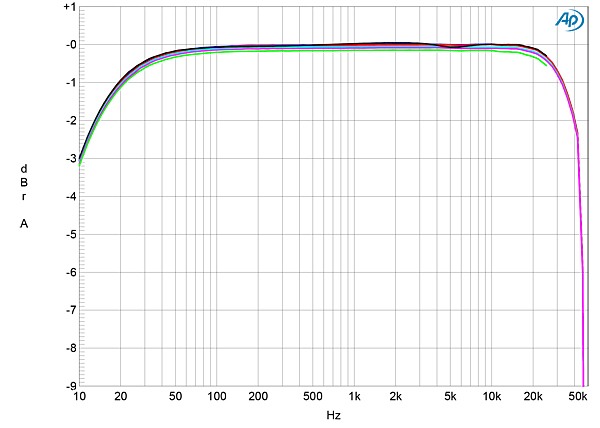
This graph was taken with the volume control set to "0.0" and neither the response nor the close channel-matching changed at different settings of the control. However, the Devialet amplifier's output rolls rapidly above 40kHz, and its reproduction of a 1kHz squarewave (fig.2) featured the symmetrical ringing indicative of a linear-phase digital filter. The 140 Pro digitizes its analog input with a sample rate of 96kHz—although the sample rate is said to be switchable between 96kHz and 192kHz, I wasn't able to change it from 96kHz—meaning that a 10kHz squarewave was reproduced with just the third harmonic at 30kHz present (fig.3).
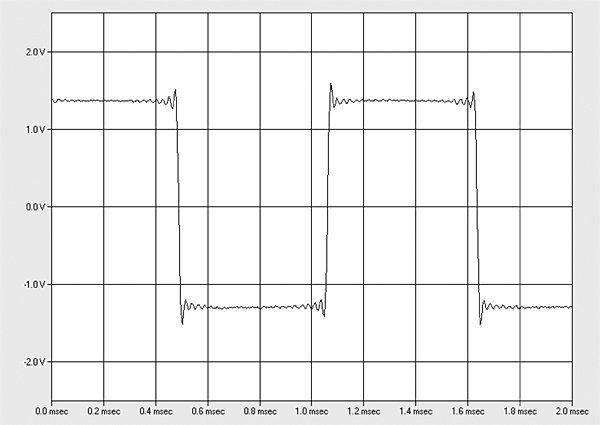
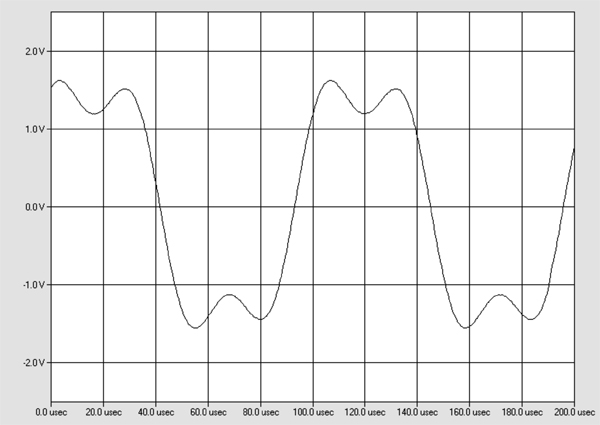
Channel separation was good, at 90dB in both directions across most of the audioband, but when I looked at the crosstalk waveform on an oscilloscope, it was apparent that the measurement was dominated by noise. This higher-than-usual level of noise can be seen in fig.4, which shows a spectral analysis of the Devialet's low-frequency noise floor. While the individual FFT bins in this graph lie at or below –80dB, it suggests that the 140 Pro's analog inputs are limited to 14-bit resolution. With the filter, the wideband, unweighted S/N ratio, ref. 2.83V and measured with the volume control at "0.0" and the input shorted to ground, was 59.5dB, which improved to 68dB when A-weighted (average of both channels). The level of random noise increased as the volume control setting was raised above "0.0." The A-weighted ratio with the control set to "30," for example, measured 38.5dB, ie, 30.5dB worse.
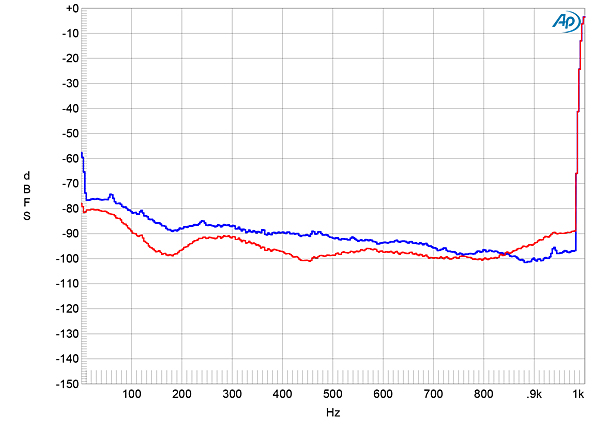
The Devialet's maximum power is specified as 140W into 6 ohms (19.7dBW). I don't have a 6 ohm test load, but with "clipping" defined as when the THD+noise reaches 1%, I found that the 140 Pro clipped at 103W into 8 ohms (20.1dBW, fig.5) and 205W into 4 ohms (20.1dBW, fig.6).
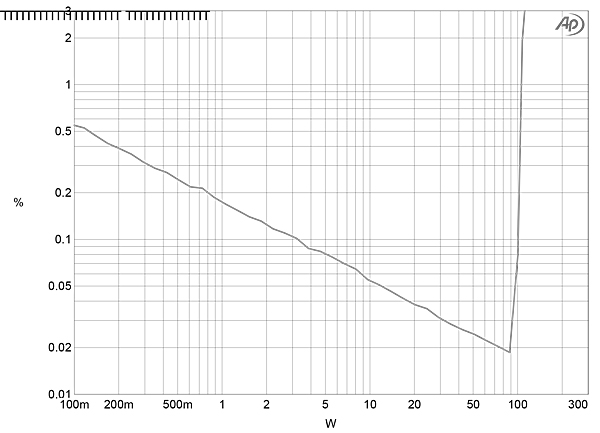
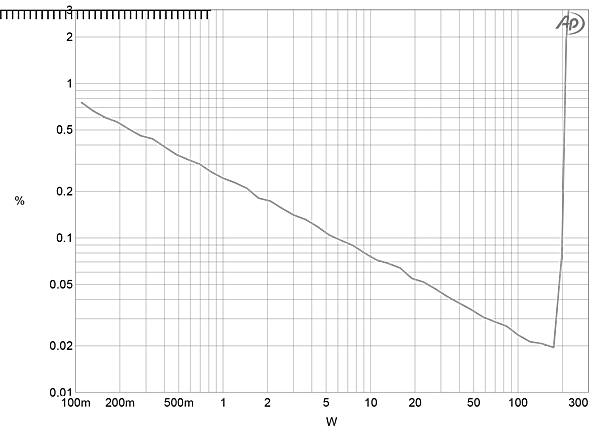
The Devialet's THD+N at full power is specified as just 0.0005%. The downward slope of the traces in figs.5 and 6 suggests that the measurement is actually just showing noise up to the point when the waveform starts to clip. (A constant level of background noise increases as a percentage as the signal level drops.) I haven't included a graph showing how THD+N percentage varies with frequency, therefore, as this graph would be dominated by noise. The waveform of the residual distortion and noise is just random noise (fig.7). But figs.5 and 6 indicate that the minimum THD+N percentage is just 0.02% into both 8 and 4 ohms.
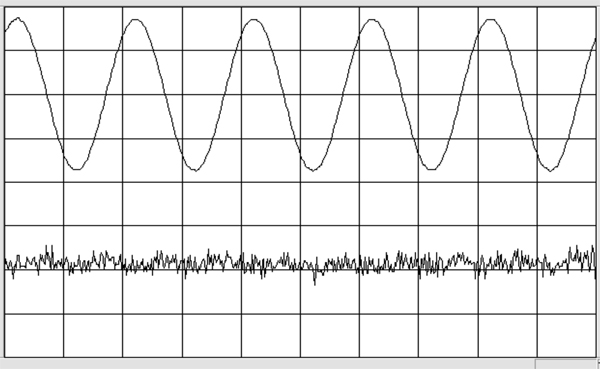
The spectrum of the Devialet's output while I drove a low-frequency tone at a moderately high power into 8 ohms is shown in fig.8; any distortion harmonics are below the level of random noise. I ran into problems when I tried to test for intermodulation distortion with my usual mix of 19kHz and 20kHz tones. The amplifier went into protection with sustained high-power, high-frequency tones, reducing the output level. The spectrum in fig.9 was taken at 8Wpc into 4 ohms, the highest power the amplifier would deliver continuously without its protection operating. Though the second-order difference product is absent, some low-level, high-order intermodulation products can be seen. However, the noise floor has an unusual scalloped appearance.

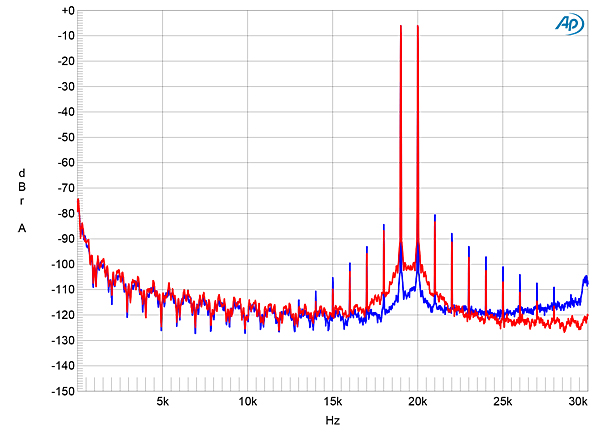
Turning to the digital inputs, Apple's USB Prober utility identified the Devialet amplifier as "Expert Pro USB Audio 2.0" from "DEVIALET" and indicated that the USB port operated in the optimal isochronous asynchronous mode. Apple's AudioMIDI utility revealed that, via USB, the 140 Pro accepted 16- and 24-bit integer data sampled at all rates from 44.1 to 192kHz. All the digital inputs preserved absolute polarity (ie, were noninverting).
With the Devialet's volume control set to "0.0," a 1kHz digital signal at 0dBFS resulted in a level of 25.18V into 8 ohms from the speaker outputs. Increasing the volume control to "2.5" clipped the amplifier's output with this signal, so I performed most of the testing via the digital inputs with the volume control set to "0.0."
The 140 Pro's impulse response with 44.1kHz data was a typical linear-phase type, with symmetrical ringing before and after the single high sample (fig.10). With 44.1kHz-sampled white noise (fig.11, red and magenta traces), the Devialet's response reached full stop-band attenuation at 24kHz, though the noise floor with this signal was higher than it was with a full-scale tone at 19.1kHz (blue and cyan traces). The harmonics of the 19.1kHz tone can be seen in this graph, with the third the highest in level, at –63dB (0.07%). The 140 Pro's frequency responses with data at 44.1, 96, and 192kHz followed the same basic shape, but with a very sharp rolloff above half of each sample rate (fig.12).
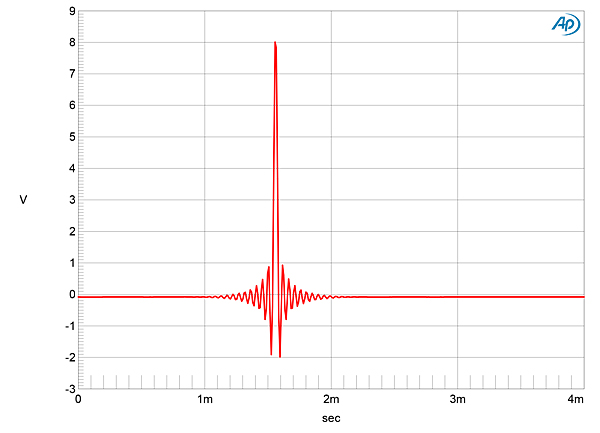

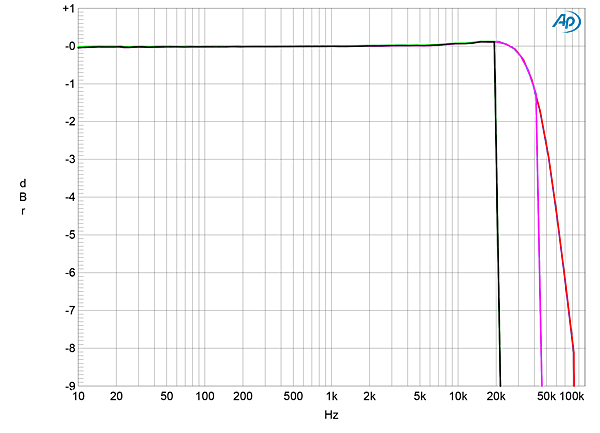
When I increased the bit depth from 16 to 24 with a dithered 1kHz tone at –90dBFS, the random noise floor dropped by >20dB in the left channel (fig.13, blue trace), meaning that the Devialet's digital inputs offer almost 20 bits' worth of resolution in this channel. However, the noise floor in the right channel (red trace) is higher than it is in the left and has an odd scalloped appearance. With undithered data representing a tone at exactly –90.31dBFS, the three DC voltage levels described by the data were well resolved and the waveform was perfectly symmetrical (fig.14). With undithered 24-bit data, the result was a superbly clean sinewave (fig.15).
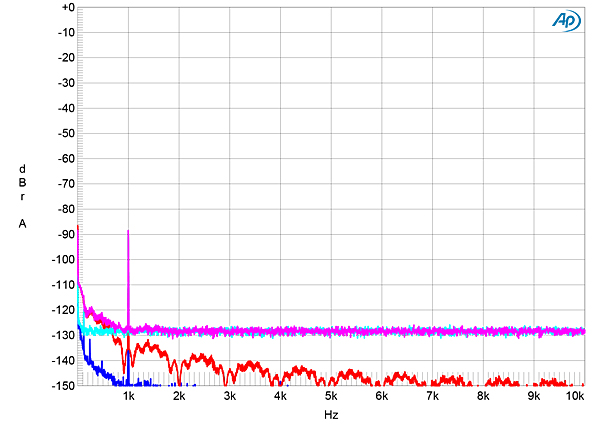
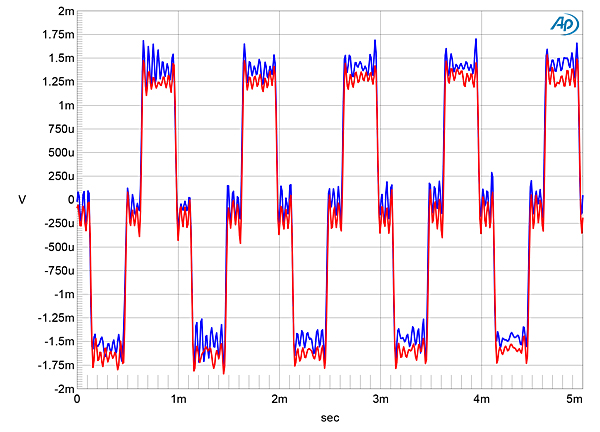
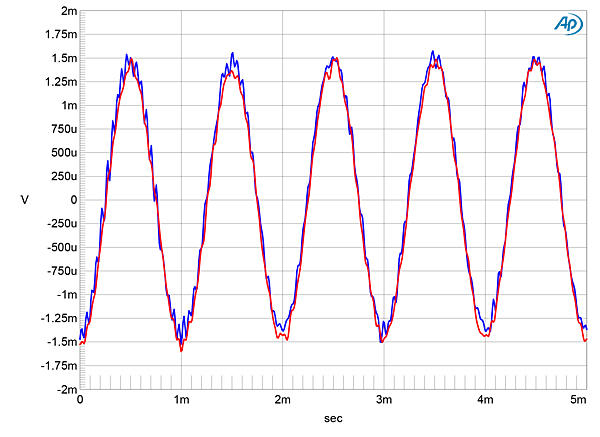
Finally, tested for its rejection of word-clock jitter with 16-bit USB data, all the odd-order harmonics of the LSB-level, low-frequency squarewave were below the level of noise (fig.16; their correct levels are indicated by the sloping green line). However, a pair of sidebands at ±120Hz to the sides of the peak that represents the high-level tone at one-quarter the sample rate can be seen, these power supply-related. Note that I had to reduce the volume to "–24" to make this measurement, to avoid the amplifier going into protection.
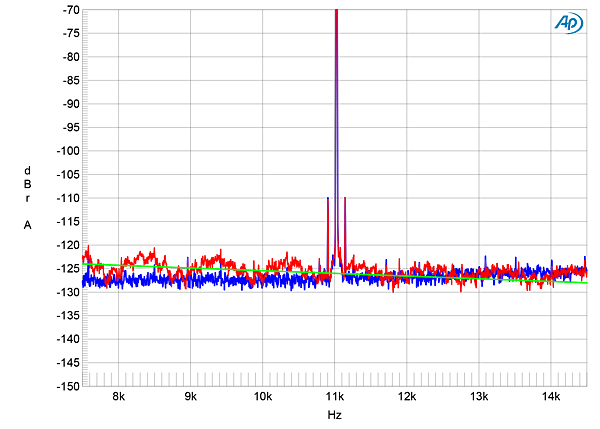
In most respects, the Expert 140 Pro measures very similarly to the much- more-expensive Devialet D-Premier, which I reviewed favorably in January 2013. However, I was bothered by the higher-than-expected level of background noise—much higher than with the D-Premier—especially with the analog inputs.—John Atkinson

and it costs 3K USD

Keep in mind that’s just a power amp. But yes, you can get better measured performance for cheaper.
The Outlaww RR2160 that Stereophile measured is <$1000 and has excellent measurements for the price, and it has subwoofer crossover filters, pre-out/main-in for DSP, tone controls, balance controls, etc.

...is no more valuable than when a tossed off opinion invalidates all prior work. When in the market I always dive straight to comments!


Even with pre-amp it is cheaper and MUCH MUCH better.

It would be interesting to see, the in-room frequency response measurements of Devialet Expert Pro with SAM, from the listening position of JCA (if, possible), with and without SAM engaged :-) ........

TAS also reviewed one of the models of Devialet Expert Pro with SAM ....... That TAS reviewer also had similar listening experience with his speakers as JCA ....... That TAS reviewer discussion about the significance of bass frequencies on the overall sound quality is an interesting read :-) .......

The wave length of 20 Hz frequency is 56 feet ...... The wave length of 40 Hz frequency is, half of that, 28 feet ....... No wonder, JCA's windows 40 feet away rattled with loud 20 Hz frequency ...... It also goes to show the bass capabilities of the Revel Salon2 :-) .......

Some of that 'too much bass' JCA heard when playing bass guitar, could be due to 'Allison effect' ........ Another good reason for obtaining in-room FR measurements of JCA's listening room :-) ........

Seems like this Devialet Outfit is showing us what the future will be for us Home Music Reproducers. ( from now on )
I've been building Music systems for a very long time, getting not so good results, spending exaggerated sums of money, trying to have fun doing it and constantly searching for "NEEDED" improvements.
Back 1963ish, when I owned a Mcintosh MC40, I'd kinda thought that Audio Gear needed to be bigger to be better. Ideas like a Devialet Amp would be SciFi exaggerations .
Egads..
Now, Devialet is reality. Pinch me, I lived to see it, I won! ( we're all winning )
Tony in Venice
ps. from now on, Home Audio Systems are probably better than my hearing.

Seems like this Devialet Outfit is showing us what the future will be for us Home Music Reproducers. ( from now on )
I've been building Music systems for a very long time, getting not so good results, spending exaggerated sums of money, trying to have fun doing it and constantly searching for "NEEDED" improvements.
Back 1963ish, when I owned a Mcintosh MC40, I'd kinda thought that Audio Gear needed to be bigger to be better. Ideas like a Devialet Amp would be SciFi exaggerations .
Egads..
Now, Devialet is reality. Pinch me, I lived to see it, I won! ( we're all winning )
Tony in Venice
ps. from now on, Home Audio Systems are probably better than my hearing.

It also has a built-in DAC, plus about the same power output as this Devialet unit - but at one-quarter the price.
https://audio.com.pl/testy/stereo/wzmacniacze-stereo/2855-denon-pma-1600ne
The Denon product also won a Hi-Fi Choice group test:
https://files.hifiklubben.com/4a500a/globalassets/tester/denon/2017/pma-1600ne-hfc-group-test-verdict.pdf

Can it rattle the windows? ....... It doesn't have SAM and DSP ....... It does't have built-in Wi-Fi access capabilities :-) .......

... is it "liquid and unperturbable"?

Denon PMA-1600NE does keep the analog signal in analog domain ....... So, if you are an analog fan and use tube phono pre-amp, then the Denon could be 'liquid and unperturbable' :-) ......

Wow. Given the hype behind Devialet's products, I expected this box to measure a lot better than it did.
I agree with the first poster about the AHB-2. Also, Bruno Putzeys' work with nCore & Purifi show that you can have Class D with vanishingly low levels of noise and distortion.
I'd be interested in you guys getting a NAD M32 on the bench. It's a very similar product.
It would seem to me that having this much noise (-80dB @ 1 watt) in a product regardless of its linearity and lack of distortion would leave a veil of haze on everything.
A decade ago, I owned a Sony TA-E9000ES digital pre-amp. In spite of it's fantastic tone controls, listening modes and alleged lineage from Sony's Oxford mixing board (which I seriously doubt), the unit was really noisy. Just like this unit. And then, one day, it just died.
I could never truly enjoy my listening experience because of the constant noise which was about 85-90dB below maximum output.
For a little less money, you can get Benchmark's AHB-2 amp & DAC3 as well as a MiniDSP Dirac processor. That will give you everything the Devialet offers, but the phono pre. You will, though, gain room correction on top of speaker correction. So long as you don't need analog inputs, you'd be getting much better performance.

Stereophile has already reviewed NAD M32 :-) .........

Bench-racing technophiles are never gone long. Too much correcting of the legions of rubes in audio remains to be done.
It's audio virtue signalling. Its ultimate expression is to reduce all audio down to about six components, none of which actually need to be experienced, much less enjoyed.

NAD M10 ($2,750) ...... Stereophile review coming soon :-) .......

NAD M10 has 2 subwoofer output connections :-) .......

The streamer functionality belongs on a separate device than can be replaced or upgraded separately from the longer life hardware (DAC, control preamplifier, power amplifier, etc.).


See Stereophile review and measurements, January 2020 issue :-) .........

Likewise I'm surprised by that 1W distortion result of ~0.2%.
Not saying this is audible of course, just that there are many amps in the Class D world capable of better than that from an engineering perspective for less money.

Well ....... Better than twice as expensive BorderPatrol power-amp :-) .......

If you consider integrated amps between $5k and $10k, more powerful 220 Expert Pro with SAM ($9,990) is also available ...... 220 Expert Pro was TAS 2019 'Golden Ear' award winner :-) ......

More powerful 300 WPC McIntosh MA9000 integrated amp is $10,500 (reviewed by Hi-fi News) ........ MA9000 has 8 band parametric EQ :-) .......

"analog signals deteriorate in ways that digital signals don't, as long as they (the digital signals) remain error-free, which technology itself can assure."
This is a ridiculous statement,particularly the final part.

Is ridicule necessary or appropriate?
Audio engineering in France has been at a consistently high level.
Tony in Venice

and self-apparently so. Very simply, digital signals have dual "natures". They exist as an analog electrical signal and as data--information. The latter aspect of their nature is of course the "digital" part; "digital", used this way, refers to the fact that each piece of information exists in one of two levels, up or down, 1 or 0, 0V or 5V, or what have you. The integrity of their digital nature can be assured with error checking--as anyone who has ever copied a CD with EAC, or done a bit-perfect test on a digital audio stream, can attest.
So while all analog signals degrade--including those representing digital data--the digital aspect of their nature in general "remain error-free," even as that degradation occurs. It is of course possible for those signals to degrade to the point where the integrity of the digital data is compromised, but this rarely happens in a properly functioning audio system.
And before you start lecturing us about jitter, bits not being just bits, and all that, please know that I'm aware of it, but it in no way contradicts what I wrote. And please notice this phrase from the review: "as long as those A/D and D/A conversions are done with great care."
Jim Austin, Editor
Stereophile

Excellent summary of the situation and clarifying the true nature of digital.

...was not addressing the equipment under review. The language I quoted distinctly reminds me of the "perfect sound forever" line we were sold by companies and reviewers way back when. It was not true then and remains untrue.

What I wrote--what you called "a ridiculous statement--was true, and it remains true.
Jim Austin, Editor
Stereophile

What you stated is a theoretical ideal - one that is never fully attained.

Jim's sentence: "Devialet's designers believe — in this they are correct — that analog signals deteriorate in ways that digital signals don't, as long as they (the digital signals) remain error-free, which technology itself can assure."
It's obviously true on a routine basis due to digital error detection and correction. If this were not, we would not be communicating with confidence that the Internet is conveying the same message across thousands/millions/billions of screens, your computer would not be able to run at >1GHz, the gigabytes of RAM would be unreliable, and terabytes of music on hard drives would be suspect.
Enough with the hand wringing and nonsense unless you have evidence to show that this were not so.

If you have been brainwashed by Pastafarian cultists into believing in the existence of the Flying Spaghetti Monster, it will be very difficult to reprogram your thinking and convince you that your deep dish plate of frutti di mare fra diavolo is merely the main course of your dinner and not the Pastafarian Holy Eucharist. ...perhaps more especially when the eating feels much like some sort of reborn religious experience.


Man, you are making me hungry :-) ......

...perhaps I should have reworked that to utilize bouillabaisse, loaves and fishes instead.


Sorry .... We will just settle for either country ham and grits or, fried chicken and grits ....... Or, may be just Buffalo wings and Budweiser :-) .......


Country ham and grits is the secret to success, the Alabama Crimson Tide had all these years ....... Alabama native Tim Apple also owes his success to country ham and grits :-) ........

Well, while I didn't exactly grow up in Alabama--we left when I was 4--most of my family was still there so we visited often, several times a year. But I did not discover true country ham--salt cured--until we started vacationing in North Carolina and Virginia. So I feel comfortable saying that it's not so much an Alabama thing.
Jim Austin, Editor
Stereophile

True .... Lot of southern states restaurants serve country ham and grits, and shrimp and grits :-) .......

If you like seafood, shrimp and grits is also excellent :-) ........

Is that French baguette with that bouillabaisse? ....... Actually, JCA likes French baguette ....... Now we know how Devialet got a favorable review :-) .......

I think the owners of the Devialet gear and the Benchmark gear should gather together with said gear and have a small party. Bet everyone comes away happy.
Now, the reference to Pastafarians got me. I recall a few years back a dispute in the local media of a Western Canadian city - the Province was refusing to issue a drivers licence to an individual because of his photo.
The official photo was of the individual wearing of his religious headgear that consisted of a plastic colander (!). Personally, I was good with it, it showed his features, and apparently a willingness to cope with linguini at any moment.
Hope he got his licence.

M2Tech Joplin Mk III DSP-based phono stage. It's possible that this is a remarkable phono preamp based on the architecture. A thorough bench test and audition would have real value.